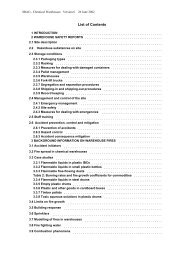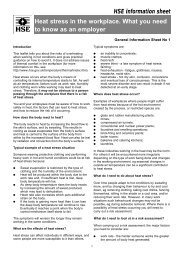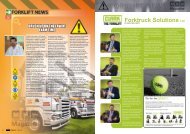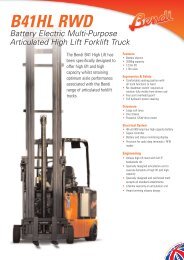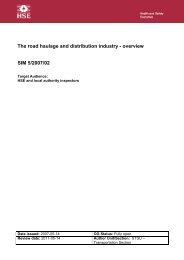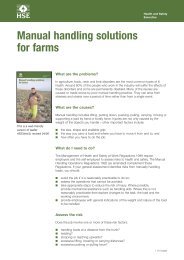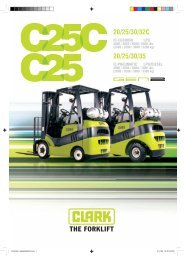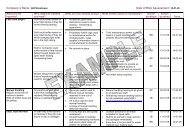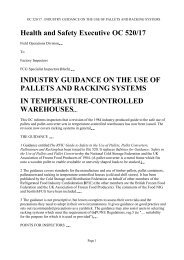Workplace transport inspection pack
Workplace transport inspection pack
Workplace transport inspection pack
Create successful ePaper yourself
Turn your PDF publications into a flip-book with our unique Google optimized e-Paper software.
Regulation 27 requires restraining systems to be fitted to certain fork-lift trucks if there are risks(particularly crushing between the truck and the ground), should the truck overturn. This appliesin particular to seated, centre-control, counterbalanced fork lift-trucks. Where such acounterbalanced truck is to be used in a high risk situation but, because of the age and designof the truck, there are technical difficulties in fitting attachment points for a restraining system,the selection of suitable alternative equipment may be the only solution. This may be aparticular problem with some older battery powered fork-lift trucks. For further information on thefitting and use of restraining systems on fork lift trucks, see HSE Information Sheet MISC 241.Regulation 28 - Self propelled work equipment. Vehicle controls including brakes; adequatevision for driver, provide vision aids (eg extra mirrors, CCTV) where needed; vehicle lights.It deals with a variety of additional measures on self-propelled work equipment, ie equipmentthat has its own engine or motor. However, little, if any, action may be needed for vehicles usedprimarily for travel on public roads where they comply with similar provisions in the RoadVehicles (Construction and Use) Regulations 1986. The extent of any such overlap (and alsothe gaps) is being looked into and the action necessary is under consideration.Regulations 28(e) and 17 (3) (a) Driver visionThere is an overlap between the requirements in reg 17(3)(a) and those in reg 28(e) driverdirect field of vision. For self-propelled mobile work equipment, the same measures, forexample additional mirrors or CCTV, can be used to meet the requirements of both regulations(see also para 64 regarding on-the-road use).Regulation 17(3)(a) can be used in relation to 'a driver’s direct field of vision' where there is asignificant risk resulting from the use of mobile work equipment, particularly where this isestablished sector policy. Inspectors should be aware however that in some situations it maybe more appropriate to use reg 28(e) as this permits risk to be reduced by means other thanimproving the driver’s vision, for instance the use of radar or other sensing aids to assist safevehicle manoeuvring (this may be relevant for example where very dusty conditions severelylimit the usefulness of visual systems).For visibility issues on earth moving equipment, see SIM 02/2007/02 “Assessing field of visionfor operators of mobile earth moving machinery used on construction sites”. See OC 803/70“Closed circuit TV on road going vehicles” for guidance on the application of CCTV to lorriesand other large road going vehicles.Regulation 28(g) - The requirement for appropriate fire-fighting appliances should only beapplied where escape from self-propelled work equipment cannot be achieved easily.Regulation 29 - Remote controlled self-propelled work equipment. Rare equipment - ifencountered see ACoP.Regulation 30 - Drive shafts. Safeguard any drive shafts (though not strictly a WT topic).4.7.3 Supply of Machinery (Safety) Regulations 1992The legal requirements for the initial integrity of workplace vehicles are not simple, but aresummarised below.For workplace vehicles supplied for use mainly off the road, section 6 HSWA and the Supplyof Machinery (Safety) Regulations 1992 (SMSR) apply, and hence such workplace vehicles aresubject to the Essential Health and Safety Requirements (EHSRs). The main EHSRs regardingvehicle movements are contained in SMSR Schedule 1, section 3 "EHSRs to offset the



